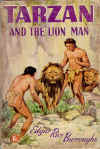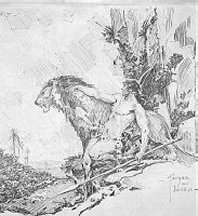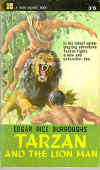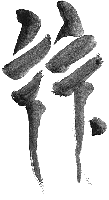
Official Edgar Rice Burroughs Tribute and Weekly Webzine Site
Since 1996 ~ Over 10,000 Web Pages in Archive
Presents
Volume 1692d
Themes And Variations
The Tarzan Novels Of Edgar Rice Burroughs
#18: Tarzan and the Lion Man
by R.E. Prindle

 |
 |
 |
Burroughs has been ridiculing Obroski right along as an arrant coward. Wherever the action is, Stanley isn't. When it's over he shows up ready to fight. When a call for the safe job of kitchen help is made after the porters desert Stanley raises his hand.
This cowardice is in contrast to his magnificent physique. Standing 6'8" or 9" inches in his bare feet while his strength is as prodigious as that of Tarzan. No one in the safari has yet seen Tarzan but he and Stanley are as identical twins. When Stanley becomes fever stricken and disappears from the story the movie cast will confuse Tarzan for Obroski providing some amusing moments.
Over the oeuvre Burroughs uses the device of a Tarzan double three times. Esteban Miranda in Golden Lion/Ant Men, here as Stanley Obroski and again in Tarzan And The Forbidden City as Brian Gregory. The doubles are quite obviously aspects of Burroughs' own character.
As they are all cowardly, inept or both one has to assume they represent Burroughs as he perceived himself before becoming a success while Tarzan represents Burroughs as a success. There was obviously a constant psychic tug of war between the two Burroughs. This was something ERB was desperately trying to resolve in favor of the Tarzan persona.
The question is, was he ever successful in resolving the problem by psychologically integrating his personality? At several times in the corpus he seems to have succeeded but then he's back to his same old dilemma. In this one also he seems to have definitely succeeded even to the extent of killing off his old persona. But then there are doubts and Brian Gregory appears a few years later.
If I live long enough I will try a comparison of Miranda, Obroski, Gregory and Burroughs. Notice the progression from Spaniard to Slav to Anglo.
As a more or less irrelevant aside it is known that Tennessee Williams (1911-83) was a Tarzan fan. He was twenty-three years old when Lion Man was issued while Streetcar Named Desire was staged in 1947. It may seem tenuous to make the connection between the names of Stanley Obroski and Stanley Kowalski but there it is. There are resemblances between Stanley-Naomi and Stanley-Blanche allowing for the fictionalizing powers of Williams. There is no proof that Williams specifically read Lion Man that I know of but it is neither improbable or impossible. Perhaps the germ of Stanley-Blanche was placed in Williams' mind in 1934-35 germinating away in his subconscious to blossom eleven or twelve years later. I don't say it's so but it is worth investigating.
In the construction of this novel the story of Obroski and Tarzan forms Ring Three. The story moves from Ring Two, The Safari and will segue into the Inner Ring.
In Chapter 8, The Coward, Burroughs devotes six pages to explaining or rather justifying the character of Obroski. In justifying Obroski Burroughs is justifying himself which is why he took such pains.
During the last Bansuto attack in Chapter 8 Obroski panicked. As the Bansuto attacked from one side Obroski ran off in the opposite direction. Unfortunately the Bansutos were on both sides and Obroski ran into their open arms. Now cornered Obroski fought from reflex. Pp. 46-47:
Death stared him in the face! Heretofore Obroski's dangers had been more or less imaginary; now he was faced with a stark reality.So, while Obroski was a coward, when he had time to consider, in the grip of terror he was quite capable of using his great strength and size to fight back.Terror galvanized his mind and his giant muscles into instant action. He seized the black and lifted him above his head; then he hurled him heavily to the ground.
The black, fearful for his life, started to rise. Obroski fearful for his own, lifted him again high overhead and again cast him down. As he did so a half dozen blacks, closed upon him from the tall surrounding grasses and bore him to earth.
His mind half numb with terror, Obroski fought like a cornered rat. The blacks were no match for his great muscles. He seized them and tossed them aside; then he turned to run. But the black he had first hurled to the ground reached out and seized him by an ankle, tripping him; then the others were upon him again and more come to their assistance...In all his life Stanley Obroski had never fought before. A good disposition and his strange complex had prevented him from seeking trouble, and his great size and strength had deterred others from picking quarrels with him.
His cowardice was not his fault or part of his nature. Burroughs reflects further. P. 45:
We are either the victims or beneficiaries of heredity or environment.Thus we have no responsibility for what we are and can take no credit as we are either victims or beneficiaries. This is a fairly serious statement.Stanley Obroski (Burroughs) was one of the victims. Heredity had given him a mighty physique, a noble bearing and a handsome face. Environment had sheltered and protected him throughout his life. Also everyone with whom he had come in contact had admired his great strength and attributed to him courage commensurate to it.It is impossible to know for certain at this time what psychology texts Burroughs had been studying but 'a psyche far too complex for easy analysis' points in the direction of Freud, Jung or both. ERB seems to have been involved in Depth Psychology of some sort. David Adams finds traces of Jung. I am not prepared to concede so much at present but David may be much more sensitive on that score than myself. I don't rule it out although I would lean more to Freud as the better known. Still, as I find ERB to be a very inquisitive guy there is no reason he couldn't have known of both. Either would likely have been mentioned in his varied reading and we know he was an omnivorous reader.
Never until the past few days had Obroski been confronted by an emergency that might test his courage, and so all his life he had been wondering if his courage would measure up to what was expected of it when the emergency developed.
He had given the matter far more thought than does the man of ordinary physique because he knew so much more was expected of him than of the ordinary man. It had become an obsession together with the fear that he might not live up to the expectations of his admirers. And finally he became afraid- afraid of being afraid.
It is a failing of nearly all large men to be keenly affected by ridicule. It was the fear of ridicule, should he show fear, rather than the fear of physical suffering, that Obroski shrank from, though perhaps he did not realize this. It was a psyche far too complex for easy analysis.At any rate it seems clear that Obroski's heredity was overridden by the conditioning of environment. Unable to overcome the conditioning or hypnotic suggestion he became as we find him.
There seems little doubt that here ERB is explaining himself. Obroski and Tarzan are identical in stature and abilities but in order to realize his Tarzanic potential he must overcome his environmental conditioning and assume his proper being.
Whether the emergency Tarzan/Burroughs is facing is his difficulty with MGM seems more than likely as the struggle is placed in the context of the MGM/BO Studios filming of Trader Horn/Tarzan, The Ape Man.
So Obroski is captured by the Bansuto and made prisoner in their village. Here he encounters Kwamudi, captain of the safari Blacks and a couple porters who had been captured after deserting. Obroski learns that the Bansuto are cannibals and that he will be the man who came to dinner.
Burroughs gets in some sly humor here. Bound and starved Obroski complains about his treatment. P. 51:
"This is no way to treat people you're going to eat." grumbled Obroski. "You ought to get ' em fat, not starve 'em thin."ERB has already given notice that he is in psychological mode. He says that Obroski's psyche is too complex for easy analysis, whatever that might be. That's what we all say and it's bosh. When I was younger I thought my psyche was so unique and complex I wanted to offer myself to science as a specimen. As my own self-psychoanalysis evolved I realized the only thing that made it so complex was the resistance involved in facing the fixations. So with Burroughs. In a few pages he lays out completely the problem he is facing in symbolical or dream imagery. Only resistance and fear prevent him from breaking on through.A psychoanalyst could lay your whole problem before you but if you weren't ready to deal with it, in other words, overcome the resistance, you wouldn't be able to see it. You'd think he was talking about someone else. So here ERB lays out his whole problem. Whether he resolved it is a matter of debate. David Adams thinks not while I have not yet made up my mind.
The problem he is dealing with is his central childhood fixation of John the Bully. I have already gone into this in Doubles and Insanity but it won't hurt to give a variant interpretation as this very key incident meets with a lot of resistance on its own.
As has been noted Burroughs was plagued by dreams of appearing naked in public. Nakedness is a significant theme in the oeuvre. Tarzan himself runs around naked except for a skimpy g-string; so Tarzan's natural condition and Burroughs dream fears mesh. He has made a virtue out of necessity.
In psychological terms John the Bully so emasculated Burroughs that he lost his offensive and defensive armor which is to say to the civilized man his clothes. ERB substitutes Rungula for John. Having Obroski captured he demands Obroski strip and give him his clothes. Nothing could be clearer than the relationship to ERB's situation on the corner. ERB explains the nature of nakedness to the civilized man. P. 58:
"He says for you to take off your clothes, Bwana," said Kwamudi, "he wants them."So, in real life, Burroughs had been psychologically stripped naked by John having lost his self-confidence. This is an accurate understanding. When he constructed his alter ego Tarzan he made him naked in his uncivilized state, hence full of self-confidence though naked, but then clothed him handsomely in his civilized state. Thus ERB attempted to resolve the problem.
"All of them?" inquired Obroski.
:"All of them, Bwana."
(Note the excruciating deliberateness as ERB painfully drags this scene out.)
Exhausted by sleeplessness, discomfort, and terror, (Here ERB makes excuses for himself) Obroski had felt that nothing but torture and death could add to his misery, but now the thought of nakedness awoke him to new horrors. To the civilized man clothing imports a confidence that is stripped away with his garments.Now when John bullied ERB he forced a split in his personality. While his physical self was humiliated his psychological self split off symbolically taking to the trees for refuge. Hence Tarzan's fabulous arboreal exploits while he views so many scenes from above in a tree.
Now come the very interesting scene in Rungula's village where Tarzan suffers the shock of recognition as he looks down on his own replica from the tree to the ground.
Tarzan is in no rush to visit Rungula's village, perhaps indicating resistance. Here's how ERB describes it. P. 61
Tarzan of the Apes was ranging a district new to him, and with the keen alertness of the wild creature he was alive to all that was strange or unusual. Upon the range of his knowledge depended his ability to cope with the emergencies of an unaccustomed environment. Nothing was so trivial that it did not require investigation; and already, in certain matters concerning the haunts and habits of game, both large and small, he knew quite as much if not more than many creatures that had been born here.Surely and old jungle baby like Tarzan could understand the language of the drums?
For three nights he had heard the almost continuous booming of tom-toms, faintly, from afar; and during the day following the third night he had drifted slowly in his hunting in the direction from which the sounds had come.And on the third day 'He was arisen.' Hmm. In Tarzan Of the Apes the birth of Tarzan replicated that of Moses and now Obroski is to die while a new Tarzan arises.
I had my attention called to this Moses part while visiting a Jewish site. The writer was marveling that Superman was Jewish and that his birth replicated that of Moses which it does. I had always thought that the two teenage Jewish boys who created Superman were replicating Tarzan's birth and that may be equally true.
In the Moses story he is born to a Jewish woman who places him in an ark putting it in the river where he floats downstream to be rescued by an Egyptian princess who rears him among a different people. This story presupposes that heredity overcomes environment which is nonsense. One is not born a Jew one is educated into the identity.
Superman is born a Kryptonite, placed in a rocket ship that crashes into this goyish earth couple's backyard. They then rear the Kryptonite child as their own who then has a double identity as an ineffective Earthman while retaining his Kryptonite powers. Thus the Jew is superior to the goy.
Tarzan too is born to a human mother who dies. He is lying in his cradle when the ape, Kala, snatches him up rearing him as her own. The different people Tarzan grows up with are the apes. Thus he too has a double identity.
All three stories are identical while Moses is First, Tarzan second and Superman third. thus in his first incarnation Tarzan appears to be a Moses figure.
In Lion Man Tarzan appears to be born again when he absorbs his other split half - Obroski. Thus on the third day Tarzan assumes a Christ like identity.
Many have noted that the initials John Clayton and John Carter are JC and they call attention to the fact that they are the same as Jesus Christ.
So, here we have Tarzan, a walking dead man so to speak, who after three nights - Good Friday to Easter Sunday - looks down on the other half of his split personality and recognizes himself. The two halves then begin a process of amalgamation becoming one again. So Tarzan/Burroughs is born again or arises from the dead.
Tarzan then unites the Old and New Testaments being at one and the same time both Moses and Jesus Christ. Fairly astonishing stuff.
Tarzan then hauls Rungula up into his tree i.e. John is brought up to Burroughs split off personality where Tarzan demands that he release Obroski i.e. John restore Burroughs other half to himself while at the same time making him promise to be always kind to Whites.
Obroski then leaves Rungula/John's village where he joins Tarzan. Thus Burroughs symbolically reunites his split personality or in other words appears to integrate his personality. At least he makes the attempt.
At the very least he has analyzed himself to the threshold of integration. Whether he actually stepped over the threshold is open to doubt. As a comparison let us examine Feodor Dostoevsky's great nineteenth century novel Crime And Punishment. There is no direct evidence that Burroughs might have read the book but the possibility exists that his curiosity led him to this very famous 1866 novel. If so, Dostoevsky's analysis of Raskolnikov might have influenced ERB on the unconscious level. I had to read the novel three times to get a conscious grasp of it.
The novel concerns the characters' dependence on women. Raskolnikov is dependent on his mother and sister who make tremendous sacrifices of their own well being to put him through law school. Raskolnikov resents his dependence yet can't tear himself from it even when offered an opportunity to do so. His solution to his psychological problem bypasses analysis for an impossible external one. He decides to symbolically kill his mother and sister hoping thus to free himself. Psychologically this is not a viable method.
As his victim he selects an old pawnbroker. This woman has large assets stored in her apartment. Thus Raskolnikov takes valuables from her in lieu of the money he is receiving from his mother. In the process he kills the old woman and when her daughter appears he kills her too. Thus he has killed surrogates of his own women. The woman's body lies before him. To free himself, according to Dostoevsky, it is necessary for him to step over the body thus completing the crime. Raskolnikov cannot do this, walking around the body instead thus negating the benefits of his murder.
In Burroughs' case his imaginary alter ego, Tarzan, convinces Rungula/John to release Obroski/Burroughs from custody. In other words exorcise the fixation. However, psychologically Rungula/John cannot do this. It is necessary for Burroughs to confront his fixation and recognize it thus negating the hypnotic suggestion that he is a coward thus freeing himself. That is the only way it can be done. Thus as Raskolnikov did not step over the pawnbroker's body so Burroughs does not cross over the threshold of integration at this time.
Instead his imaginary self, Tarzan, attempts to teach his temporal self, Obroski, to be brave and fearless. Hence, in what might be seen as high comedy, Tarzan introduces the Faux Lion Man to the real lion. However Tarzan advises Obroski to be careful around Jad-Bal-Ja's new love of whom Tarzan has no experience.
As soon as Tarzan disappears Obroski/Burroughs who had been treed by John scurries for the security of the lower terrace where he cowers until the Big Bwana's return. Subsequently he catches fever not unlike Raskolnikov, if Burroughs read Crime And Punishment. Tarzan entrusts the unconscious Obroski to a native chief to nurse. From that point on Tarzan assumes both identities as the movie company who have never seen him and are unaware the he and Obroski are twinlike mistake him for Obroski which Tarzan lets them do. Obroski then dies.
If Burroughs thought he had solved his problem by wishing himself into the role of Tarzan he had to be mistaken. As Jung pointed out in Mysterium Coniunctionis one cannot will one's fixations away. No matter what temporary success you may enjoy the fixation will out.
In the role of Tarzan Burroughs set himself an impossible task to perform. Tarzan is an ideal to hold before oneself for emulation's sake but an impossible role to fill. Burroughs admitted this in his posthumously published novel Tarzan And The Madman in which in the end he simply gets into a plane and flies into the sunset.
The story of the two Lion Men forms the third ring of the story. We will now examine the inner ring, the center of the storm, and then the other side of ring three, the parallel story of the two female lookalikes, Naomi and Rhonda.
R. E. Prindle welcomes your comments at:
dugwarbaby@yahoo.com
|
and Follow the Navigation Chart for the Entire Series of Articles |
|
Differing viewpoints are welcome. |
|
are not necessarily those held by Edgar Rice Burroughs, Inc. |


BILL HILLMAN
Visit our thousands of other sites at:
BILL AND SUE-ON HILLMAN ECLECTIC STUDIO
ERB Text, ERB Images and Tarzan® are ©Edgar Rice Burroughs, Inc.- All Rights Reserved.
All Original Work ©1996-2006/2010 by Bill Hillman and/or Contributing Authors/Owners
No part of this web site may be reproduced without permission from the respective owners.